|
Heliograph
A heliograph () is a solar telegraph system that signals by flashes of sunlight (generally using Morse code from the 1840s) reflected by a mirror. The flashes are produced by momentarily pivoting the mirror, or by interrupting the beam with a shutter. The heliograph was a simple but effective instrument for instantaneous optical communication over long distances during the late 19th and early 20th centuries. Its main uses were military, surveying and forest protection work. Heliographs were standard issue in the British and Royal Australian armies until the 1960s, and were used by the Pakistani army as late as 1975. Description There were many heliograph types. Most heliographs were variants of the British Army Mance Mark V version (Fig.1). It used a flat round mirror with a small unsilvered spot in the centre. The sender aligned the heliograph to the target by looking at the reflected target in the mirror and moving their head until the target was hidden by the unsilvered spot ... [...More Info...] [...Related Items...] OR: [Wikipedia] [Google] [Baidu] |
Optical Communication
Optical communication, also known as optical telecommunication, is communication at a distance using light to carry information. It can be performed visually or by using electronic devices. The earliest basic forms of optical communication date back several millennia, while the earliest electrical device created to do so was the photophone, invented in 1880. An optical communication system uses a transmitter, which encodes a message into an optical signal, a channel, which carries the signal to its destination, and a receiver, which reproduces the message from the received optical signal. When electronic equipment is not employed the 'receiver' is a person visually observing and interpreting a signal, which may be either simple (such as the presence of a beacon fire) or complex (such as lights using color codes or flashed in a Morse code sequence). Modern communication relies on optical networking systems using optical fiber, optical amplifiers, lasers, switches, rout ... [...More Info...] [...Related Items...] OR: [Wikipedia] [Google] [Baidu] |
Heliotrope (instrument)
The heliotrope is an instrument that uses a mirror to reflect sunlight over great distances to mark the positions of participants in a land Surveying, survey. The heliotrope was invented in 1821 by the Germany, German mathematician Carl Friedrich Gauss. The word "heliotrope" is taken from the Greek: ''helios'' (), meaning "sun", and ''Trope (linguistics), tropos'' (), meaning "turn". History Heliotropes were used in surveys from in 1821 through the late 1980s, when GPS measurements replaced the use of the heliotrope in long distance surveys. George Everest, Colonel Sir George Everest introduced the use of heliotropes into the Great Trigonometric Survey in India around 1831, and the United States Coast and Geodetic Survey used heliotropes to survey the United States. ThIndian specification for heliotropeswas updated in 1981, and the American military specification for heliotropes (MIL-H-20194E) was retired on 8 December 1995. Surveyor (surveying), Surveyors used the heliotr ... [...More Info...] [...Related Items...] OR: [Wikipedia] [Google] [Baidu] |
Mirror
A mirror, also known as a looking glass, is an object that Reflection (physics), reflects an image. Light that bounces off a mirror forms an image of whatever is in front of it, which is then focused through the lens of the eye or a camera. Mirrors reverse the direction of light at an angle equal to its incidence. This allows the viewer to see themselves or objects behind them, or even objects that are at an angle from them but out of their field of view, such as around a corner. Natural mirrors have existed since Prehistory, prehistoric times, such as the surface of water, but people have been manufacturing mirrors out of a variety of materials for thousands of years, like stone, metals, and glass. In modern mirrors, metals like silver or aluminium are often used due to their high reflectivity, applied as a thin coating on glass because of its naturally smooth and very Hardness (materials science), hard surface. A mirror is a Wave (physics), wave reflector. Light consists ... [...More Info...] [...Related Items...] OR: [Wikipedia] [Google] [Baidu] |
Colorado
Colorado is a U.S. state, state in the Western United States. It is one of the Mountain states, sharing the Four Corners region with Arizona, New Mexico, and Utah. It is also bordered by Wyoming to the north, Nebraska to the northeast, Kansas to the east, and Oklahoma to the southeast. Colorado is noted for its landscape of mountains, forests, High Plains (United States), high plains, mesas, canyons, plateaus, rivers, and desert lands. It encompasses most of the Southern Rocky Mountains, as well as the northeastern portion of the Colorado Plateau and the western edge of the Great Plains. Colorado is the List of U.S. states and territories by area, eighth-largest U.S. state by area and the List of U.S. states and territories by population, 21st by population. The United States Census Bureau estimated the population of Colorado to be 5,957,493 as of July 1, 2024, a 3.2% increase from the 2020 United States census. The region has been inhabited by Native Americans in the United St ... [...More Info...] [...Related Items...] OR: [Wikipedia] [Google] [Baidu] |
Signal Mirror Mount Wilson 2014
A signal is both the process and the result of transmission of data over some media accomplished by embedding some variation. Signals are important in multiple subject fields including signal processing, information theory and biology. In signal processing, a signal is a function that conveys information about a phenomenon. Any quantity that can vary over space or time can be used as a signal to share messages between observers. The ''IEEE Transactions on Signal Processing'' includes audio, video, speech, image, sonar, and radar as examples of signals. A signal may also be defined as observable change in a quantity over space or time (a time series), even if it does not carry information. In nature, signals can be actions done by an organism to alert other organisms, ranging from the release of plant chemicals to warn nearby plants of a predator, to sounds or motions made by animals to alert other animals of food. Signaling occurs in all organisms even at cellular levels, w ... [...More Info...] [...Related Items...] OR: [Wikipedia] [Google] [Baidu] |
Turkish Heliograph At Huj2
Turkish may refer to: * Something related to Turkey ** Turkish language *** Turkish alphabet ** Turkish people, a Turkic ethnic group and nation *** Turkish citizen, a citizen of Turkey *** Turkish communities in the former Ottoman Empire * The word that Iranian Azerbaijanis use for the Azerbaijani language * Ottoman Empire (Ottoman Turkey), 1299–1922, previously sometimes known as the Turkish Empire ** Ottoman Turkish, the Turkish language used in the Ottoman Empire * Turkish Airlines, an airline * Turkish music (style), a musical style of European composers of the Classical music era * Turkish, a character in the 2000 film '' Snatch'' See also * * * Turk (other) * Turki (other) * Turkic (other) * Turkey (other) * Turkiye (other) * Turkish Bath (other) * Turkish population, the number of ethnic Turkish people in the world * Culture of Turkey * History of Turkey ** History of the Republic of Turkey * Turkic languages ... [...More Info...] [...Related Items...] OR: [Wikipedia] [Google] [Baidu] |
Carl Friedrich Gauss
Johann Carl Friedrich Gauss (; ; ; 30 April 177723 February 1855) was a German mathematician, astronomer, geodesist, and physicist, who contributed to many fields in mathematics and science. He was director of the Göttingen Observatory and professor of astronomy from 1807 until his death in 1855. While studying at the University of Göttingen, he propounded several mathematical theorems. As an independent scholar, he wrote the masterpieces '' Disquisitiones Arithmeticae'' and ''Theoria motus corporum coelestium''. Gauss produced the second and third complete proofs of the fundamental theorem of algebra. In number theory, he made numerous contributions, such as the composition law, the law of quadratic reciprocity and the Fermat polygonal number theorem. He also contributed to the theory of binary and ternary quadratic forms, the construction of the heptadecagon, and the theory of hypergeometric series. Due to Gauss' extensive and fundamental contributions to science ... [...More Info...] [...Related Items...] OR: [Wikipedia] [Google] [Baidu] |
University Of Göttingen
The University of Göttingen, officially the Georg August University of Göttingen (, commonly referred to as Georgia Augusta), is a Public university, public research university in the city of Göttingen, Lower Saxony, Germany. Founded in 1734 by George II of Great Britain, George II, King of Great Britain and Electorate of Hanover, Elector of Hanover, it began instruction in 1737 and is recognized as the oldest university in Lower Saxony. Recognized for its historic and traditional significance, the university has affiliations with 47 Nobel Prize winners by its own count. Previously backed by the German Universities Excellence Initiative, the University of Göttingen is a member of the U15 (German Universities), U15 Group of major German research universities, underscoring its strong research profile. It is also a part of prominent international and European academic networks such as Guild of European Research-Intensive Universities, The Guild, the ENLIGHT alliance, and the Hek ... [...More Info...] [...Related Items...] OR: [Wikipedia] [Google] [Baidu] |
Geodetic Survey
Geodesy or geodetics is the science of measuring and representing the Figure of the Earth, geometry, Gravity of Earth, gravity, and Earth's rotation, spatial orientation of the Earth in Relative change, temporally varying Three-dimensional space, 3D. It is called planetary geodesy when studying other astronomical body, astronomical bodies, such as planets or Natural satellite, circumplanetary systems. Geodynamics, Geodynamical phenomena, including crust (geology), crustal motion, tides, and polar motion, can be studied by designing global and national Geodetic control network, control networks, applying space geodesy and terrestrial geodetic techniques, and relying on Geodetic datum, datums and coordinate systems. Geodetic job titles include geodesist and geodetic surveyor. History Geodesy began in pre-scientific Classical antiquity, antiquity, so the very word geodesy comes from the Ancient Greek word or ''geodaisia'' (literally, "division of Earth"). Early ideas about t ... [...More Info...] [...Related Items...] OR: [Wikipedia] [Google] [Baidu] |
Utah
Utah is a landlocked state in the Mountain states, Mountain West subregion of the Western United States. It is one of the Four Corners states, sharing a border with Arizona, Colorado, and New Mexico. It also borders Wyoming to the northeast, Idaho to the north, and Nevada to the west. In comparison to all the U.S. states and territories, Utah, with a population of just over three million, is the List of U.S. states and territories by area, 13th largest by area, the List of U.S. states and territories by population, 30th most populous, and the List of U.S. states by population density, 11th least densely populated. Urban development is mostly concentrated in two regions: the Wasatch Front in the north-central part of the state, which includes the state capital, Salt Lake City, and is home to roughly two-thirds of the population; and Washington County, Utah, Washington County in the southwest, which has approximately 180,000 residents. Most of the western half of Utah lies in ... [...More Info...] [...Related Items...] OR: [Wikipedia] [Google] [Baidu] |









